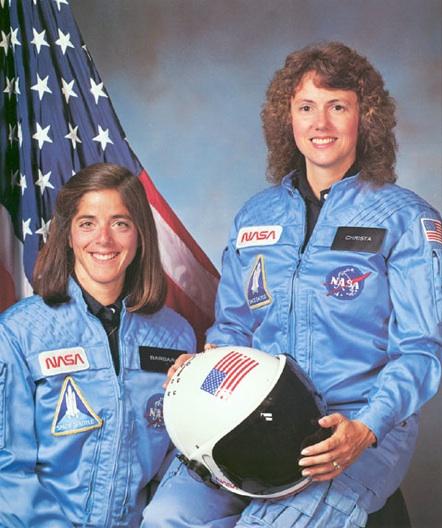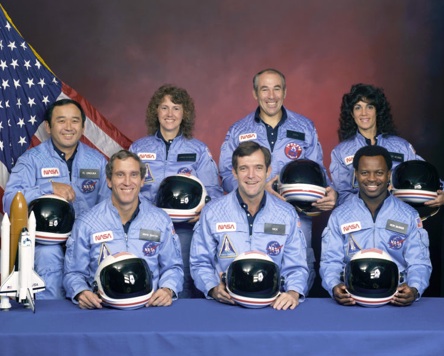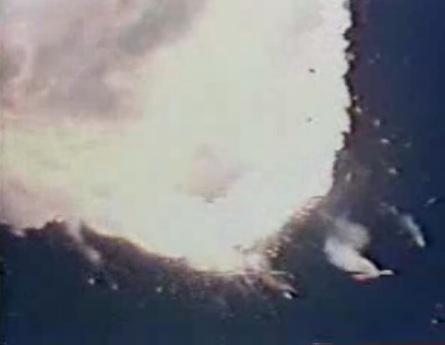Author's Note: Please excuse some of the blurry photographs. Since this was 1986 the photographs weren't the best in the world.
You may be wondering why I'm writing an article on a teacher. Everyone knows we come to Whyville to escape school. But, this isn't about some teacher who died from cancer and founded an organization. No. This is about a teacher who wanted to go up into space. But she never made it there.
Christa McAuliffe wrote to NASA for the "Teacher In Space" program. It was a program meant for an educator, a regular person, a teacher to go up in space, teach a lesson, and spark the minds of students everywhere further into space. Christa McAuliffe taught Social Studies, History, (whatever you prefer to call it . . . ) at Concord High School in Concord, New Hampshire. She wrote in her entry to the Teacher in Space program in 1984 and received the announcement that she would be traveling to space on July 19, 1985. Along with runner-up, Barbara Morgan, she jumped into immediate astronaut training for the tough road ahead.
Barbara Morgan (left) and Christa McAuliffe (right)

They trained with 6 other astronauts:
(From left to right on the top row)
Ellison S. Onizuka, Sharon Christa McAuliffe, Greg Jarvis, and Judy Resnik.
(From Left to right on the bottom row)
Michael J. Smith, Dick Scobee, and Ron McNair.

The day finally came. January 26, 1986 arrived and Christa and Barbara were both professional astronauts. But the day before, January 25, NASA had to decide whether or not they should let Challenger soar, the spacecraft the crew would be flying in. They had weather predictions of rain and heavy winds. Not to mention it was unusually cold at the Kennedy Space Center in Florida. So they decided to delay the launch to Monday. Unfortunately, the weather was beautiful! A perfect day to launch passed. Christa and Greg Jarvis, even though in quarantine, passed the day with a bike ride throughout the Kennedy Space Center grounds.
On Monday they were ready for take off. They got all situated but when they tried to lock the doors, a bolt was in the way! It took a whole 2 hours to undrill the screw and get it hooked back together. When they shut the doors NASA looked at some troubling news. There were heavy rains, cold weather, and gusts of winds moving in that would not be good for the shuttle. Another day, another 4,000 million dollars wasted!
So Tuesday came, and Christa and the crew were as ready as ever while Barbara twiddled her thumbs down below. Christa's parents, Grace and Edward Corrigan, were down below with their grandson's school class along with several other of the astronauts' families. Finally, the countdown began. A man from mission control came over on the overhead speaker and his dull voice said, "10-9-8-7-6-5-4-3-2-1! Lift off! We have lift off!"
The Challenger took flight, it's engines burning out fire. Everyone screamed and cheered as Challenger soared to the sky. But no one noticed the mysterious black smoke leaking out from the side of one of the boosters. Up, up, up! It seemed nothing would stop Challenger on that sunny and bitter cold morning in Florida. Barbara Morgan screamed "Good-bye!" to Christa and the crew and laughed. But 75 seconds into the flight, Grace and Edward looked up.
And boom.
The Challenger exploded. Everyone down below screamed in confusion. No one knew what had happened. Barbara Morgan stopped laughing and screamed in confusion. She ran down from her view point and pushed her way past security as she neared the launch pad. "I don't see it," Edward said. Grace nodded.
The Challenger blew up and made a large white cloud in the sky. Two pieces of debris flew up, making it almost look like a rock hand like they sell in Akbars.



An emergency crew was sent out. They searched for surviving astronauts. But all they could find were broken pieces of debris and three helmets from the astronauts.
NASA applies an emergency oxygen cord on the helmets for when there is an emergency but the astronauts had to pull them. They discovered all three had been activated. A disturbing fact. Three astronauts had been conscious/alive when the Challenger exploded. Scientists think that they survived the two and a half minute fall to the ocean but the impact of the water hitting their bodies killed them.
Now you're probably wondering what made the Challenger explode? On the boosters of the rockets there are O-Rings which when gas and fuel is pressed to shoot outward the O-Rings loosen to keep the pressure from the fuel inside so the booster won't explode. But on that freezing morning, icicles and ice covered everything, making the O-Rings on the right booster stay in place. When they didn't expand, scorching hot black smoke leaked out and it was pouring all over the attachment from the booster to the actual rocket. After a while the heat basically melted the attachment away making the bottom of the rocket fall apart. The top of the booster rammed into the top part of the tank and BOOM.
Almost 20 years later, one man, James Chiles (pronounced like "child" but without the 'd'), wasn't so sure that was why the Challenger blew up and investigated further into the situation. He decided that the O-Ring couldn't possible be all that was wrong. The black smoke that leaked out was caused by the O-Ring. But two seconds into lift-off it disappeared. Something blocked the gap. Almost a minute into the flight it came back, billowing out. But there was no proof that the hole did reappear. Sp, Chiles watched the video again. When the Challenger exploded there was an unusual sight. The smoke from the tanks and boosters left a zig-zag trail, followed by a vertical trail, and then it exploded in the sky. That means a strong wind might have pushed the Challenger off course.
Let's rewind and discover what the real problem was.
The fuel ignited and ran down the boosters. The O-Rings loosened and started to wave back and forth letting black smoke leak through. It started to burn away the O-Ring. Then a piece of debris from the fuel blocked the hole and that's why it didn't explode immediately on the launch pad. The Challenger traveled up, up, and up! Then a huge gust of wind knocked it off course. The Challenger recovered but the debris in the O-Rings is knocked loose and then it starts melting the O-Rings again. The O-Rings completely melt away and the bottom of the booster becomes detached causing the Challenger to shake violently. The attachment from the booster to the fuel tank becomes detached causing the bottom of the fuel tank to fall off too. Then the top of the booster hit the top of the fuel tank and KABLOOEY!
The sad part is, there was nothing wrong with the actual shuttle, Challenger. It was the fuel and gas that caused the whole thing to blow up.
Christa McAuliffe died along with the six other astronauts that day. All because of something NASA could've prevented by not launching and inspecting the boosters more.
Barbara Morgan gave up her teaching career and became a professional astronaut. She has flown on one successful mission, STS-118 on August 22, 2007.
Here are several quotes from Christa McAuliffe:
"I cannot join the space program and restart my life as an astronaut, but this opportunity to connect my abilities as an educator with my interests in history and space is a unique opportunity to fulfill my early fantasies."
"I touch the future. I teach."
"No teacher has ever been better prepared to teach a lesson."
"Reach for it. Push yourself as far as you can. "
And here is a quote from Barbara Morgan:
"You know, there's a great sense of pride to be able to be involved in a human endeavor that takes us all a little bit farther. When you look down and see our Earth, and you realize what we are trying to do as a human race, it's pretty profound." -August 2007
McAuliffe's dream of making it to space was never fulfilled. But think of how much she's touched us as a whole. She challenged us to go for our dreams!
"What are we doing here? We're reaching for the stars!" -Christa McAuliffe
-msof57
Author's Note: I know Wikipedia isn't the best sight for sources but I inspected all of them very carefully with the help of my computer applications teacher and we both agreed they have accurate information.
http://en.wikipedia.org/wiki/Barbara_Morgan
http://en.wikipedia.org/wiki/Christa_McAuliffe
http://en.wikipedia.org/wiki/Space_Shuttle_Challenger_disaster
Another one of my sources is a video we watched in my English class called "Seconds from Disaster- Space Shuttle Challenger"
I've found the whole episode on YouTube for those who are interested in seeing in. It is in five parts because of the limitations on YouTube:
http://www.youtube.com/watch?v=KCEmwKhI-hc
http://www.youtube.com/watch?v=5YU7MJtCHqA
http://www.youtube.com/watch?v=umIJ1yjZTz0
http://www.youtube.com/watch?v=4gis45MSP8M
http://www.youtube.com/watch?v=R4xKaK7Th4A
Another video is a news broadcast seeing the Challenger explode without all the extra drama.
http://www.youtube.com/watch?v=5hQL0NWS1Rc&feature=related
I know these aren't the best sites in the world for sources and more information but it's really the best I can do. If you happen to know of any better sites for information on the Challenger please share in the BBS. Thanks a bunch!